Black Keys Member Patrick Carney and His Early Days in Kent’s Music Scene
July 22, 1997, and August 31, 1997
When an acquaintance of mine, Gabe Schray, posted some vintage Kent photos to his Facebook page, I was blown away to see future Black Keys member Patrick Carney playing at Europe Gyro in the summer of 1997. Back in those days, the Gyro had a really cool scene that involved everyone I knew who was making music. The gigs were easy to book, and they had live music on Sunday and Tuesday nights. Sometimes I would be down there with all of my friends seeing bands made up of people we all knew, and on other nights I would find some whole other scene.
Kent’s music scene in the mid-to-late 1990s was certainly vibrant, but it wasn’t so centralized, and the music definitely varied. There were lots of little pockets and crews of young musicians and artists around who did their own things and had their own followings. In the late 1990s, there were a lot of different venues in town: Brady’s Cafe, the Mantis, the Robin Hood, the Avenue, the Garage, Europe Gyro, and a healthy house show scene. Now, to put this into perspective, 1997 was long after the North Water Street heydays of the Kent Kove, JB’s, and the Water Street Saloon. It was a completely different period for live music.
So, the photos of future Black Keys member Patrick Carney as a seventeen-year-old playing with his high school band at Europe Gyro really validated my impression of Kent as a long-running magnet and breeding ground for some really great art and artists.
But the pictures mean something much more personal to the musicians who actually took part in these two shows. They tell stories of these Akron kids playing in bands and coming to Kent, but, more broadly, they dip into the story of one local youth music subculture.
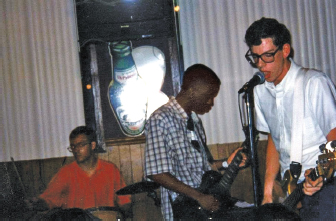
Gabe Schray, Jermaine Blair, and Patrick Carney performing at Kent’s Europe Gyro (Photo by Philip Swift)
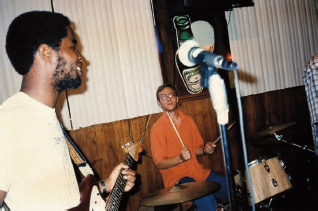
Steve Caynon and Gabe Schray at Kent’s Europe Gyro (Photo by Philip Swift)
Filmmaker Philip Swift took the pictures. Swift’s award-winning 2010 Sincerely P.V. Reese is a documentary about a lot of the kids who were in attendance on these nights at the Gyro. That summer, Swift was just about to enter his senior year at Akron’s Firestone High School. Fifteen years later, he remembers the shows well:
These photos were snapshots taken in the moment probably with some disposable camera or an actual SLR camera. These are definitely from two different nights. The one that I am looking at right now is Gabe on the left, Jermaine [Blair] in the middle, and Pat on the right. Gabe is wearing a nondescript orange shirt in this one, and in the next one he’s got on a Jawbox T-shirt. Also in this one photo Steve [Caynon] has on a Spiritualized T-shirt, and in the other one he is wearing a Nick Cave and the Bad Seeds shirt with what possibly looks like a polo underneath. The two black and whites would be from one night and the three color photos from a different night.
I remember many nights at Europe Gyro, at the Mantis, and at all these other different little venues from that period. I can’t even think of them all right now. I couldn’t even tell you the exact dates on these shows.
I come from a very close-knit, [large] group of friends. Throughout high school there were these little times where we all had got fed up individually with each other, and so we wouldn’t be around as much. Since Pat Carney is in these photos, I would have to say this is 1997. By senior year of high school, he had kind of given up on all of us and moved on. I think he was doing postsecondary stuff from Firestone to Akron University.
Everybody in those photos, we all went to the same elementary school, the same middle school, the same high school, and we were like a big group of friends forever. And Gabe, obviously, I still have a big connection with, and Pat, as busy as he is, he still took the time to text me on Christmas.
So we were all friends, and a bunch of [the guys] were musicians and they all practiced music on some level. Steve had older siblings that were into music, Gabe’s dad was really into music production, and Pat’s uncle is, obviously, Ralph Carney, who had played on all of those Tom Waits albums and has done work with countless others of that caliber. So all of these people had music connections to begin with.
I never ever had any musical bone in my body. I could never carry any rhythm or play any instruments or anything, and so I was the guy that was there with the camera who would photograph stuff. I also made weird music videos with these guys.
At the time of these Gyro shows, we all worked at the Mustard Seed Market, and because of this we knew people that were a little bit older and who were involved in the Kent scene, so that may have been how these shows got booked. I was just happy to show up and hear some great music and take photos.
I remember on one of the nights I drove to the show with some people, and I definitely remember knowing about a show coming up at Europe Gyro. Every night was kind of the same. Basically, you would show up and you’d be really excited because your nerdy rock-and-roll friends were playing a show at the Europe Gyro and you’d get to be part of the entourage, posse. We, as friends of the band, would always show up way too early and make a lot of fuss outside the venue, [fooling] around and getting in trouble, and then when the show started we were down front just flipping out and loving every note those guys played. Whether it was really good or not, we were always there ready to have a great time.
I was always more about capturing the moment as it happened rather than thinking about framing and composition and such. [In] the other black-and-white photo, you can see Gabe and Steve [are] looking right at the camera, and they are kind of like smiling. It’s a weird photo, because everyone seems very happy, but you can’t tell if it’s because they wrapped up a good show or because they are about to play a good one.
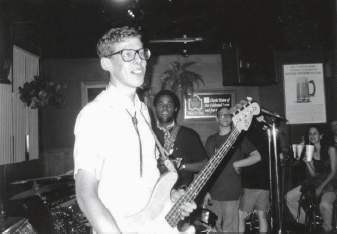
Patrick Carney, Steve Caynon, and Gabe Schray at Kent’s Europe Gyro, with Ted Gerbick and Colleen Ganon in the background (Photo by Philip Swift)
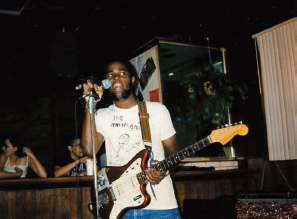
Steve Caynon (Photo by Philip Swift)
It’s interesting to think about what these photos meant back then and what they mean now. Back then I was proud and happy to be with my friends and see them play this live music. It was always a big event for us, whether it was in the tiniest little basement in someone’s house in Akron or the Europe Gyro or the Mantis. And I certainly lived vicariously through all of them getting onstage and performing. So I was always excited to be there to take pictures or shoot some video of my friends playing.
I just wanted to have photos to show these guys so that right after I could say, “Hey guys, this is what you looked like while you were playing,” or, “Look at you guys smiling at the camera; you guys look like a bunch of goofs.”
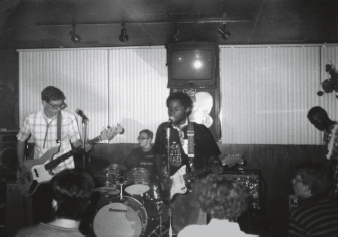
Patrick Carney, Gabe Schray, Steve Caynon, and Jermaine Blair performing at the Europe Gyro. Pat’s brother Michael Carney is in the audience (lower right). (Photo by Philip Swift)
Gabe Schray is an amazing man and is the most prolific musician I know. He is constantly putting out music, and he is a ridiculous individual and a ridiculous human being. He is always up for bizarre, weird, fun adventures. He is a total goofball, but I love him, and he’s great. And Pat Carney obviously now is a multimillion-dollar rock icon almost.
It’s interesting to look at Gabe and Pat as these two opposite ends of the spectrum of the Northeast Ohio–Akron music scene. Pat as a huge rock star who goes on Saturday Night Live and plays with the Rolling Stones and [is] making a lot of money, and Gabe producing an album every year of whatever he wants to put out. One will be an electronic reggae album and the next album can just be ambient tones.
The third person in these photos is Steve Caynon, who was literally my best friend. We were in kindergarten together; he’s definitely the closest thing to a brother I ever had until I married Katie. And Steve died in 2004, and all we have are these photos and these films we made.
When I teach, I talk a lot about how photography is about capturing less than a second. We can look at these photos of these nights from Europe Gyro and we can ask, “What happened before these photos? And what happened after?” I think before is a little blurry but the after is pretty obvious. And the present is just these guys enjoying the art form that they always enjoyed, which is just rockin’ out for their friends.
Musician and artist Gabe Schray, the drummer in the pictures, was a huge part of that old Akron crew, and he continues to play live shows and produce music. He produced and composed the soundtracks to both of Phillip Swift’s films, The Bubble and Sincerely P.V. Reese (in which he also appears). On these Europe Gyro nights in Kent, Gabe was just seventeen. Fifteen years later, this was his take on the photos:
Christopher Whispers started because we were all in high school, and I think just before we put the group together we were all playing louder punk rock than straight rock. But by this time, we had gotten really into bands like Galaxie 500, which was just a lighter, spacier kind of thing that had some actual songwriting. We must have been sixteen or seventeen years old, and that would have been 1997.
At the time this was our exclusive band, and we were all about it, although we would switch around a lot of the same musicians within the different bands. As I recall, right at the beginning of our senior year of high school we decided to take this band real seriously. I think there was a possibility of us opening up for Luna at the Grog Shop, and that was big-time—though that show never materialized.
We actually did some four-track recordings, and I still have the cassette tapes along with hundreds of other cassette tapes in a giant briefcase. I think there were two recording sessions, and those were held in Pat’s basement. He had the nicer four-track, and he had the drum set. Those recordings would have been done in the fall of 1997.
Christopher Whispers probably only played three actual shows, and two of them were at Europe Gyro in Kent. The only other one was for a house show in Akron in Jermaine’s basement. That might have been it, and those photos that Philip took would reflect both of those public shows.
I do remember a few things. I know that for one of those nights, there was a big bar fight where somebody threw a bar stool while we were playing. And while that didn’t have anything to do with us, it was very exciting for us teenagers to be in the midst of a barroom brawl. That was the first and only band I played drums in, and I kind of remember screwing off a couple times during one of those shows and being self-conscious about it. Jermaine’s guitar was real noisy, and I’m not sure he ever played the same thing twice. We were probably pretty noisy. We were all seventeen years old and feeling like adults for the first time—playing a real show in a real public place in front of strangers in another town.
There wouldn’t have been anyone else on the bill for those nights but us. We didn’t know how something like that worked. We didn’t really understand that usually for these kinds of shows multiple bands should be booked.
Pat must have booked those two Gyro shows. Even back then he was good at talking, networking. Pat was always precocious and ambitious. He was the first one of us to have a job on his own, which was at the Mustard Seed Market when he was like fifteen, and even before that he was mowing yards when he was ten and eleven, and he had his own lawn-mowing company. And then he had a paper route, too. He was the one saving up to buy the equipment that I still can’t afford, and he was always the real go-getter and wanting to do things on his own. So then later he was the one going out and getting the shows.
At the time of these Gyro shows I was not really aware of the Kent scene at all. It was only a few months later that I kind of realized that there was this whole other group of people in Kent who were our peers and doing the same kinds of things with music and bands, though they were a little older, maybe a few years older. The Kent kids were like the cool older kids. The real breakthrough for us into that scene was that we went to high school with a guy, Jeff France, and he was in that Kent band Pankration. Because of that I totally started becoming aware of the Kent scene. But at the time of those Gyro shows with Christopher Whispers we were in our own little weird world.
The breakup of the band was in early 1998. First Jermaine disappeared, and we couldn’t get ahold of him anymore. Then we got into this sort of high school argument with Pat, and he wasn’t really talking with us. I remember Steve and I being really worried that we wouldn’t have the master tapes of the Christopher Whispers recordings. And I think I talked Pat’s dad into letting us go down into the basement to get something, and when we went down there, we stole the master tapes. Pat was really upset about that. I don’t think they would still exist had I not done that.
That isn’t the only time that we had to sneak into his basement studio. Probably around the time of the Black Keys’ second album, our band Intelligent Knives was recording in his basement. We recorded like six songs, and then he went out on tour with the Black Keys for a while, and we really wanted these mixes. And once again, we talked the people he was living with into letting us go down into the basement to mix the record. There is sort of a long tradition of breaking and entering into Pat’s basement.
I’m not sure why Kent has this creative magnetism to it. I draw a lot of parallels between my crew in Akron with that Kent crew. People like Jamie Stillman, Joe Dennis, Ryan Brannon, and Jon Finley. Those guys were in Party of Helicopters, and they had this whole big group of friends that sort of stretched out from that band. We all have similar senses of humor and the way we interact with each other is pretty funny. Like once you start to actually get to know them, they were just the same breed of weirdo.
Party of Helicopters was one of like the top five most important bands to me. It was because of them that I had this realization that there’s this entire crew of people who we don’t know who are making cool stuff. And they were further ahead of me and my crew. Party of Helicopters were putting out records and 7-inch [records], plus Jamie Stillman had his record label, so they just really inspired me.
I remember being really passionate about [Party of Helicopters], and seeing them at the Mantis was like probably in my top favorite shows of all time. I remember being totally swept away by them live, but it just doesn’t seem like something an outsider would ever get. In Akron they seem to still have a ton of young fans now. When they did those few reunion shows in recent years, there was a huge crew of these twenty-one-year-old kids that were just freaking out and loving it.
Not everybody in my Akron crew got caught up with the Kent crew, but Steve and I did for sure. While we were at Kent State, we were just obsessed with that scene. Pat got into that Kent crew, too, and that’s actually how we kind of started talking again after Christopher Whispers broke up. When Steve and I went off to college in the fall of 1998, there was still this sort of animosity with Pat, but [it] was kind of slowly being stripped away as he kind of became more friends with a lot of those guys. I think Pat was as obsessed with Party of Helicopters as Steve and I were, and then later Jamie Stillman, who was the driving force behind Party of Helicopters, became the Black Keys’ tour manager.
In the late 1990s there was a pretty healthy house show thing going on. It was more in the basements of people’s houses and in these other odd spaces in Kent and Akron. I mean that scene in the late 1990s meant a lot more to, or as much as, that scene that the Numbers Band or Tin Huey meant to those people in the ’70s and early ’80s. It gets weird because there are people from my parents’ generation that were in the same kind of bands, the local, do-it-yourself kind of bands, and I almost feel like they were shoving that. I guess what I am trying to say is not one is more important than the other.
I guess I should say it would be hard to dismiss Tin Huey and the like. People liked to talk Tin Huey up, but to me it was just like, “Huh? I don’t really get this.” I like it now, and I can appreciate it now, but back in the mid-to-late 1990s, it was just kind of this baby boomer thing, like them telling us what’s important. It just didn’t mean anything to me. Later on, Tin Huey kind of embraced my band Houseguest and they were all super cool with us. Some things you kind of have to get away from so that later you can look at it with some perspective. I shouldn’t say that that generation didn’t influence us kids, because we were all DEVO fanatics.
I did end up playing with Pat again. I was in that Churchbuilder band briefly that he was a part of just before and right at the beginnings of the formation of the Black Keys. Churchbuilder was Pat and his now ex-wife and a couple other people. They were like a pop band, and they were signed to Shelflife Records, an indie pop label. I was just an auxiliary live member. I wasn’t on any of the recordings, but I played trumpet and guitar live, so I kind of never refer to it as my band. But they were signed to a legitimate record label, and they recorded a full-length album and an EP, which I think [is] out of print now. That would have been around 2000–2002. I probably played four or five shows with them at the Lime Spider, the Grog Shop, and at the Beachland [Ballroom], which is where they opened for Jonathan Richman.
Thinking about what has happened with Pat now with the success of the Black Keys—at this point it’s kind of surreal. I’ve seen them since the beginning, and every time they would make some kind of move I would think that this was as far as this band could possibly go. One memory that really sticks out is that I traveled to Australia with them for New Year’s 2004, ’05. They were playing at this giant festival, and I remember sitting backstage and looking out into this sea of people and just thinking, number one, “This is completely insane.” But, number two, “This can’t possibly get any bigger. There is no way. Where can it go from here?” And I remember sitting back there thinking this was probably it for them. And then every year since then they somehow exponentially get more and more popular. It’s pretty fascinating. But yeah, I distinctly remember that De La Soul came on after them, and I was thinking this is completely insane.
I guess at this point they are as popular as you can get, but we’ll see as they continue. I actually got a text or something from Pat recently, saying, “Yeah, I am going to be playing with the Rolling Stones.” And I didn’t really know how to respond except to say, “Oh, that’s really strange.” It doesn’t make any sense, but that’s okay.
Philip must have given [the photos] to me a few years ago. He always had a camera with him; those were the days before digital photography, so it always seemed like he had a 35 mm or one of those little crappy disposable cameras. I like these pictures for just the personal history aspect. I originally posted them to Facebook because they had Steve in them, and we all miss Steve so much.
Looking again at these old photos from the Gyro, I just think of how exciting it was to be doing that sort of creative thing on our own at that age. I think people kind of thought we were weird because we had taken it upon ourselves to seek out these other endeavors. We were trying to carve out our own circuit with our own rules. It was definitely the first sense that we can do these sort of things ourselves—on our own and on our own terms. These nights at the Gyro were definitely the start of something that has been a big part of my life.
As I began writing about those nights at the Gyro, I never thought I would actually be able to speak to Patrick Carney, but after making a few inquiries, I was put on the phone with him almost immediately. He was driving from his home in Nashville to a studio where the Black Keys were recording a new album.
I think we started the band Christopher Whispers in maybe late May of 1997. Steve and I were both listening to a lot of the same music and also hanging out with Jermaine quite a bit. I think it was the three of us that started the band, or at least the three of us started talking about putting a band together first, and then I think Gabe volunteered to play drums or something like that. We used to rehearse in Jermaine’s basement, and he was like twenty-two and we were all seventeen. It was cool being in a band with an older dude, because you could make noise at his house.
The name Christopher Whispers was actually a joke. It was like a character that I came up with. We used to sit around and draw comics at school, and we just thought it was kind of a pathetic-sounding name. I think that’s why we wanted to use it.
There were definitely two different nights we played at the Gyro, and I know that the first of the two shows was the one where you can see I’m wearing the bolo tie in the photo. But yeah, there were two separate shows. But they both would have been in the same month or six weeks of each other. I think that first show would have probably been in late July, and the second show would have been towards the end of August. And this was the summer before all our senior years in high school.
Back then, Steve and I had another band at one point, called Example Figure Three, and Gabe, Steve, and I had another band as well. And then Gabe and Steve and a few other friends had bands. Yeah, in high school there were about five or six bands existing within a group of like eight people. We all worked at the same place, so basically we would start bands based on what jobs we had at the restaurant; if you had the same job you couldn’t be in the same band together, because more than likely you’d have to both work alternating days.
I’d saved my money up from that job to buy a four-track, and we used to sit around and make demos and stuff, so all the shows that we ever played in high school were booked from sending a cassette tape to somebody. It could be that Jermaine helped book those Gyro shows; that was the first show any of us had ever played at a real bar.
Though we would have known about the Gyro just from coming to Kent. I think the very first show I ever played in a band ever was in Kent, and that was with Steve [and Gabe Schray] and our friend [Greg Adonia] at the Mantis, which is over on North Water Street. And that was probably in 1995, because I couldn’t drive. One thing I remember about that show is that right when we showed up, I was the first one at the door and one of the guys who was putting on the show was standing there smoking a pipe or like a bong or something, and my dad, who had driven us to the show, was right behind me coming up to the door. I was lucky my dad didn’t see it, because my dad can’t smell. So we were aware of all that for sure, like all the different places to play in Kent. I wasn’t friends with Jamie Stillman yet, but I knew who Jamie was, and I knew about Donut Friends, and I knew about Harriet the Spy and Sockeye and all of the stuff going on in Kent.
Back at that time there was nothing like Kent in Akron at all. Because Kent is a smaller town more geared towards students, it’s always been a place I think that’s kind of inherently cooler than Akron. That’s how we viewed it. It was a place where you could go see a show downtown on a Friday night at the Europe Gyro or the Mantis or check out some albums at Spin-More Records. And at the same time, my uncle Ralph was a musician and he was in a band called Tin Huey, and they got signed to Warner Brothers playing at a show at JB’s in like 1977. Back then, there was like really cool [stuff] coming through Kent into the mid-1980s.
The coolest thing about Kent in the mid-to-late 1990s, though, was really the Mantis, and we knew that you could get decent shows at other places, too. I remember Dave Neeson was booking shows at Susan’s Coffee and Tea, though JB’s had turned into a frat bar by the time we were old enough to go play shows. There was the Avenue, too, but that was more of a sketchy place. And then there was the Robin Hood, and, I mean, there was always kind of cool [stuff] going on in Kent.
As far as distinct memories I have from those nights, I remember we had a lot of friends from high school who came out. Not that many people were actually there. Maybe there were forty people. I just remember being happy to be playing a show. I felt like Steve and Jermaine and Gabe and I had put an awful lot of time into practicing and getting something cool together.
The photos are fascinating, but to be honest I don’t remember much about Philip taking them or really too much about those shows in general. I remember being there, and without ever seeing Philip there I know Philip would be there because he was really good friends with Steve, Gabe, and me. It wasn’t until maybe a year ago that someone sent me the one shot with all of us from far away. That was really the first time I saw a picture of that band.
Honestly, the summer of 1997, the first half of that summer, was probably the most fun time I ever had in high school and one of the most fun times I’ve ever had in my life, and it was mainly because of that band Christopher Whispers, because Steve and I were always listening to new music and getting into that kind of stuff. When we had time off, we would go to the guitar store or record store. We were just all about music. We were listening to Yo La Tengo and Galaxie 500, the Feelies, stuff like that, and that was influencing the music we were making. I think that was the first time any of us were in a band that was a little more mellow. I don’t even think Steve had a single fuzz pedal or anything.
Later, I actually hung out in Kent a lot. Steve and Gabe went to Kent State the next fall, and I ended up kind of [messing] around going to some art school and then going to Akron University, and at Akron U I started hanging out with this band called the Phelps Hex. Phelps Hex were two bass guitars and drums, and they were friends with Jamie Stillman, so we would go visit Kent all the time because the Phelps Hex would play shows with Party of Helicopters at the Avenue, and that’s how I got to know Jamie.
Jamie and I were always super friendly, and then at one point the last label that Party of Helicopters was on, Velocette Records, I think Jamie arranged for them to come meet with us and maybe try to sign us [the Black Keys], while we signed to Fat Possum. And through that whole deal I ended up hanging out with Jamie a lot more. A year later, Dan and I had a really strange tour scheduling thing where we had to start our tour in Seattle. So we asked Jamie if he would drive our van out for us and we would meet him there. That was the beginning of Jamie becoming the Black Keys’ tour manager, which didn’t actually click in fully for another year, year and a half. And then he was the Black Keys’ tour manager for the next five years. He was an awesome person to be spending tours with.
It’s hard to even think about Kent without bringing up Jamie Stillman, because that was like one of the most alluring things about Kent. All this [stuff] was coming out of Kent and you can all kind of trace it back in some way to Jamie.
I first heard about Jamie Stillman when I was thirteen, and this is like pre-Internet and you know, Kent is twenty miles away. So, for like a fifteen-year-old or sixteen-year-old for your name to just travel to west Akron is the equivalent to being a punk rock superstar in Akron. We had some friends who were a little bit older than us who’d go to Kent [and] would be like, “Jamie’s got an 8-track recorder and a cassette and he’s got a label and he’s got like two bands.”
I think at that time the band he was in was called Velocipede, and then Harriet the Spy and all that. It was all very inspiring. They were all coming from a place musically that I wasn’t really, but the thing that I always liked about them was that I loved the music that they made. Those guys all listened to such cool [music], and they were always super supportive of every band no matter what the genre or whatever you know. Dave Neeson and Tom Raichel and all those guys and Joe Dennis especially. And basically how Dan [Auerbach] and I figured out how to get the Black Keys going was just seeing Party of Helicopters get in a van and tour like every single summer for six or seven weeks. We just realized that that’s what you kind of have to do. And any time the Black Keys would have a bad show or something, I’d always think about Jamie’s stories about being on tour and like playing in some kid’s basement and his parents came home and [stuff] like that.
That was the thing, just watching Jamie and all those kids in Kent. They would be like, “Oh, you need to make a T-shirt? Here is how you make a T-shirt.” Or they’d be like, “Oh, you want to put out an album? You just call United Press, and you do this, and you send them this, and it costs this much money.” They just knew how to make this stuff happen.
Reflecting on these photos and thinking about where my career has gone since these nights in 1997, I can tell you that I know that my seventeen-year-old self would think that my thirty-two-year-old self was cool. I don’t think I could have ever imagined most of the things that have happened to me in the last couple of years. From the age of seventeen until I was probably about twenty-three—and this includes a couple years of touring and playing in the Black Keys—the only successful band that I ever saw live was Dinosaur Jr., and they played to like 1,500 people at the Cleveland Agora Theater. So, for me, real success and being in a big band meant to be able to sell out or pack pretty tight a venue like the Grog Shop. I think all that other stuff—I mean I never watched the Grammys or saw a concert at Blossom or the Gund Arena or any of that. So all of that stuff was not even something I was paying attention to.
These shows at Europe Gyro weren’t my first shows or anything, but it was the first time I ever played at what was more of an actual venue versus a DIY kind of spot. It was the middle of summer right before our senior year of high school. Those photos and those nights at the Gyro literally mark the end of an era. Everybody’s [situations] just changed within months of that.
As I was putting this story together, I went down to the Europe Gyro, or Eurogyro, as it’s now officially known, several times, to take photographs and order food, just see the place again. It was the same crowd and vibe that I remember—just different faces. Some nights, the place was packed front to back with kids who came from who knows where to see a triple bill of bands. On other nights, it was hip-hop DJs. Most of the time, though, I saw that same young rough Gyro crowd trying to eat, drink, and converse over an extremely loud jukebox.
The Gyro remains the exact same gritty establishment that it was back in the mid-to-late 1990s, the very last vestige of an old neighborhood, while everything around it has moved slickly into the twenty-first century. Perhaps visitors stay at the new hotel next door only to be bewildered by all the ratty-looking kids hanging outside of the pizza place.
The Wallflowers played at Kent State on Thursday, December 11, 1997.
Wallflowers Play to Crowd of 4,147
By Dawn Piros
Daily Kent Stater
December 12, 1997
The Wallflowers performed before a standing crowd of 4,147 last night in the Memorial Athletic Convocation Center.
Complete with psychedelic flowers on the wall, chandeliers and velvet curtains, the band portrayed an intimacy that kept the audience captivated.
“Kent is very cool, very, very snowy and very big,” Wallflowers keyboardist Rami Jaffee said before hitting the stage.
“The only problem we’ve had is that there is no way to get anywhere. We were stuck in our hotel all day, there are no taxis in this town,” he said.
Jakob Dylan replied, “They’re all lies,” and jumped onto the stage.
The crowd jumped to its feet as the band opened their set with a remake of Rod Stewart’s “Tonight’s the Night,” which immediately set the mood.
“One Headlight,” the band’s third song had the audience screaming and clapping along.
“I enjoyed the show very much, and loved the light show too.” said Beth Carpenter, 33. “I think Jakob Dylan is the next Bruce Springsteen.”
Anticipation was everywhere prior to the performance.
Even third graders showed their enthusiasm.
“I like The Wallflowers because they have a good tune,” said Valerie Trizzino, who attended with her parents.
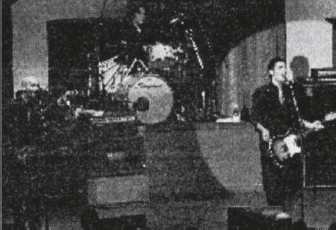
The Wallflowers performing in Kent (Daily Kent Stater photo by Dave Rubins)
She pointed to the picture of Jakob Dylan on her large T-shirt and said he was her favorite.
All Campus Programming Board President Shane Crowl said the ACPB will lose a few dollars on the show. “It’s a catch-22 situation. We try to offer students the cheapest prices we can because they pay through allocations,” he said. “However, we make more money selling tickets to non-students.”
Fugazi participated in the May 4, 1970, commemoration.
Fugazi Show Closes off May 4, 1998
By Jennifer Fiala
Daily Kent Stater
May 5, 1998
Fugazi packed the Kent State Student Center Ballroom full of 1,400 screaming fans for a free show as part of the May 4, 1970, commemoration.
“I wanted to come for the commemoration, and I like the idea of student activism as opposed to the events of 1970,” Fugazi vocalist Ian MacKaye said. “The atmosphere surrounding a lot of universities right now is that there really isn’t room for activism.”
MacKaye said he was invited to Kent State by Steve Skovensky, Kent State alumnus and supporter of the May 4 Task Force.
“Over the years, I’ve spoken with Steve about coming here, and he’s invited us a few times,” MacKaye said. “Our schedules just never worked. I just knew that this year we’d be here on May 4.”
Skovensky describes Fugazi as a Washington D.C. band that has risen out of the post-punk period to become a national act with a large underground following.
“Fugazi has turned down headlining spots for shows like Lollapalooza,” Skovensky said. “They don’t do videos or sell T-shirts—it’s just about the music.”
Fugazi bassist Joe Lally said the band often does shows to support charities and to raise money for causes they support.
“In D.C. all of the shows we play are to raise money for local causes,” Lally said. “We would like to be able to improve something in our hometown. I wish we could do it more. One of the great things about being in a band is being able to do something besides play for people.”
Because the ballroom only seats 1,400, task force members and security guards had to turn people away at the door.
“It’s a fire code, and I feel bad that we can’t let more people in,” Skovensky said.
“I’m not surprised of the turnout. It seems like every year, the anticipation is upped, and people realize the importance of activism, the legacy of May 4 and social commitment. Fugazi is one of the strongest and most important bands of our time.”
The task force set up an information table that displayed the famous 1970 Life magazine issue with the body of Kent State student Jeffrey Miller on the cover.
They also had T-shirts for sale, pamphlets and photos of student activism from the era.
Mark Kaminski, a freshman graphic design major said he liked the show but wished it had been held outside.
“I think this is a great show especially because Ian MacKaye is a leader of the straightedge movement from the ’80s,” Kaminski said. “It’s too bad that the show isn’t outside, because a lot of people couldn’t get in. I just wish more people were dancing.”
The event was sponsored in a joint effort by May 4 Task Force and All Campus Programming Board and co-sponsored by Amnesty International, Lesbian Gay Bisexual Union–Kent, Anti-Racist Action and Coalition for Animal Rights and the Environment.
Arlo Guthrie headlined the Kent State Folk Festival on Saturday, September 12, 1998.
Folk Fest Springs Roots in Kent
By Kevin Necessary
Daily Kent Stater
September 15, 1998
It was Saturday night when Arlo Guthrie finally sang “Alice’s Restaurant.”
The elusive classic, which Guthrie updated and highly improvised, was perhaps the highlight of the 32nd Annual Kent State Folk Festival, presented by the All Campus Programming Board.
The tune, laden with political commentary about Presidents Richard Nixon and Bill Clinton, 37 8-by-10 color glossy photos and its usual “instruments of destruction” capped off two nights of local, national and international folk music performances on the University Commons.
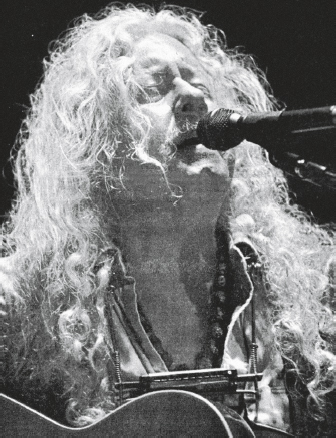
Arlo Guthrie performed songs including “Alice’s Restaurant” during Kent’s Folk Fest. (Daily Kent Stater photo by Lindsay Semple)
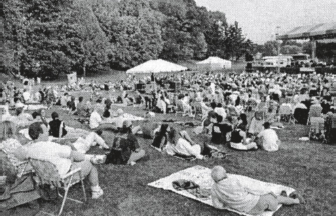
Crowds await the start of the 32nd Annual Kent State Folk Festival. (Daily Kent Stater photo by Joe Mclntyre)
The concert began Friday night at 7:00 P.M. with the Celtic sounds of Cathie Ryan, followed by acoustic guitarist and Dave Matthews Band member Tim Reynolds.
As the sun sank further behind the twin stacks of the Heating Plant, the audience was treated to performances by Iris DeMent, Czech “New Grass” artists Druha Trava and the light-hearted songs of Livingston Taylor.
Saturday’s lineup began with Music from the Hearth, composer Ken Bonfield with bass guitarist Michael Manring, Kent almnus Joe Crookston and headliners Donna the Buffalo and Guthrie, who received two standing ovations.
But it was not just the live performances that drew audiences to the concert, which on Saturday broke all previous Folk Festival records, ACPB President Brian Hanner said.
It was the chance for the audience to experience a genuine folk festival.
“This is my reason for living,” joked Frances Kovacs, a transfer student to Kent State who has attended two previous Folk Festivals.
“I came here to see Donna the Buffalo,” Kovacs, a musical theatre major, said. “And the music, because I play folk guitar in my spare time.”
Liz Pechersky, a freshman elementary education major, has never been to a folk festival but decided to come on Saturday.
“I don’t normally listen to [folk music] but it’s pretty good,” she said. But it was not the music that made the Folk Festival special for Pechersky.
“It’s the food,” she said.
But the experience of the festival was not limited to those who had to pay to get in.
To Ken Bonfield, the festival was a chance to have some fun.
“Festivals are my favorite.” said Bonfield, one of the artists who performed Saturday night. “Playing outdoors has its own issues.
“It’s harder to hear, it’s harder to get all the electricity right, but it’s absolutely the most fun, at least for me.”
Bonfield, who plays in five to ten folk festivals a year around the country, said that festivals give the audience and the musicians a chance to become closer to both each other and to the music.
“When you get to play for people,” said Bonfield, “and when you can really get 200 to 2,000 people and bring them together as one, that’s a magical thing. The audience is the most important thing to live music. Obviously, it wouldn’t be live music without the audience.
“When they laugh at your jokes, and when they understand the music that you’re playing, that’s magic.”
The Folk Festival concerts also affected those who made the show possible.
To Jacelyn Fitzwater, festival arts coordinator for ACPB, the festival was a learning experience. She had never been to a Kent State Folk Festival and was now expected to run the entire weekend.
The Smashing Pumpkins played at Kent State on Easter Sunday, April 23, 2000.
Smashing Pumpkins, Bunny Rock
By Rachel Wenger
Daily Kent Stater
April 25, 2000
When Peter Cottontail’s trail crossed the MAC Center on Sunday evening, the poor rabbit didn’t know what had hit him.
The Smashing Pumpkins brought their Sacred and Profane tour to Kent State Sunday evening, fully equipped with music from their latest CD, MACHINA/The Machines of God and a five-foot inflatable Easter Bunny.
Billy Corgan, the band’s lead vocalist, greeted the audience of 4,678, with the air-filled hare and a few words about the holiday.
“I guess this does confirm we’re pagans. We came all the way from hell to play this concert,” he laughed.
Brad Powell, concerts chair for ACPB and an employee of Belkin Music, said Belkin chose the campus specifically for the Smashing Pumpkins show.
“This size venue really worked for them,” Powell said. “This is bigger than the Agora and smaller than the CSU Convocation Center.”
With an almost sold-out show, there is no denying the Pumpkins are continuing as a smashing success.
Drummer Jimmy Chamberlin returns on MACHINA/The Machines of God, after being kicked out of the band following the release of the 1995 Mellon Collie and the Infinite Sadness. Also, former Hole bass guitarist Melissa Auf der Maur has replaced Pumpkins bassist D’Arcy Wretsky, who had been with the group since the beginning.
Fans from Pennsylvania, New York and Ohio traveled to check out the band’s new member and lyrics.
Robert Good, an Ohio University student, came from Youngstown for the show. He said he enjoys the Pumpkins’ new material just as well as the old.
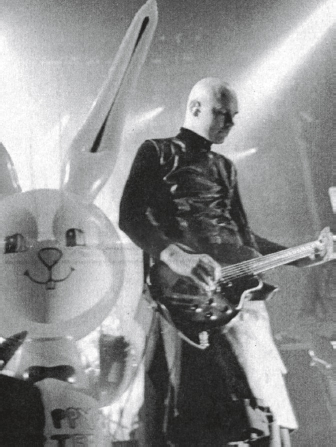
Billy Corgan of the Smashing Pumpkins performs alongside an inflatable Easter Bunny. The imitation rabbit eventually was sacrificed to the crowd. (Daily Kent Stater photo by Alex Capaldi)
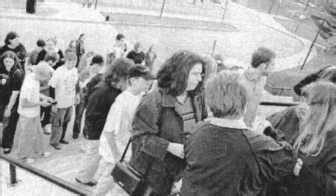
Kent State University employees assist in distributing wrist bands for Smashing Pumpkins concertgoers. (Daily Kent Stater photo by Alex Capaldi)
“I’ve liked the Pumpkins since 1991,” Good said. “If you’re a true fan, you enjoy everything they do. They know how to mix soft and hard rock together perfectly.”
Fast-paced, colored stage lights and sweaty fans didn’t miss a beat keeping up with tunes such as “Tonight” and “Everlasting Gaze.”
Some audience members donned feather boas and leather pants while others slipped in ear plugs.
When Corgan belted out the words to “Heavy Metal Machine,” proving the band knows how to have some heavy metal fun, standing floor fans tossed each other around and swayed together in the tightly packed audience.
Kent State student Bethany Mallett, came to see one particular pumpkin.
“Billy Corgan’s lyrics are untouchable,” she said. “He is in a dying breed of rock ’n’ rollers.”
Fans were greeted by metal detectors before entering the MAC Center, which is usual concert procedure, said Jim Singleton, head of Hall Entertainment security.
Singleton said even though the music may sound destructive, the fans usually aren’t.
“I’ve probably worked 20 Smashing Pumpkins concerts and we’ve never had any problems,” he said. “The audience just kind of monitors itself. The fans are just here to have fun and to have a good time.”
A Smashing Life
Guitarist James Iha Discusses Life in the Band
By Lisa Aichlmayr
Daily Kent Stater
April 25, 2000
James Iha, guitarist for the Smashing Pumpkins, had been looking forward to the concert at Kent State, but it was also another step in his career with the band.
“The only thing I know about Kent is the Crosby, Stills and Nash song,” Iha said. “But I think it will be pretty cool. I think Kent has an interesting history.”
Iha’s own history with the band started when he joined 11 years ago. He said the biggest highlight of his tenure was staying together and the freedom.
“We get to make music and put out records,” Iha said. “I’m not at work from 9 to 5, doing something I’m not interested in. It’s a hard schedule, but in the time we have off I don’t have to answer to anything. I’m kind of used to it; it’s what I do.”
Iha said even though he did not write on the most recent album, he has written on others. He said his inspiration can be almost anything that starts him playing. He starts with chord progressions then adds lyrics later.
He said the current album, MACHINA/The Machines of God, wasn’t meant to be a different style, as some reviewers had commented.
“It was just the songs we wrote and the best collection,” Iha said. “It wasn’t a decision to make a different album, it was just the way it came out.”
Iha said the current album took eight months to record. He said he enjoys playing the songs, but the touring can make them somewhat repetitive.
“There’s a repetition to playing five nights a week. It’s not that we get sick of it, but we add songs and take some out to keep it fresh,” he said. “A lot depends on the audience.”
Iha also remembers his first live concert with the Pumpkins.
“I was scared and nervous,” he said. “It was one of those ‘putting yourself on the line’ things. There’s no way to see it, there’s lights, sounds, and you’re either good, bad or whatever.”
Finally, Iha shed little light on the origin of the band’s name.
“It’s one of those names you just come up with,” he said.
The MTV Invasion Tour visited Kent on October 14, 2000.
MTV Invades Kent Homecoming Weekend
By Jennifer Johnston
Daily Kent Stater
October 17, 2000
The MTV Interactive Village had students living out their musical fantasies Saturday afternoon. Then Black Eyed Peas, De La Soul and Wyclef Jean performed for their pleasure that night. Both events were part of MTV’s Campus Invasion that hit Kent State during the music channel’s October tour of universities across the nation. Kent State was one of two universities (along with University of Virginia) where MTV taped segments to air on the network. MTV’s visit coincided with Kent State’s Homecoming festivities, creating an atmosphere of excitement for those who stayed the weekend.
Seven MTV attractions lined the area between Dix Stadium and Summit Street in the Interactive Village. A giant inflatable MTV logo stood near the street so passing cars could see this was MTV territory. [Attractions] included Techtronica, Rocks Off, Hip-Hop History, MTV’s 100 Greatest, M2 requests and Choose or Lose. Many students walking into this invasion walked in with wide eyes and excited smiles, but had mixed reviews once they played around the area.
Camella Johnson, a junior computer information major, said she came there to experience as much of the event as possible.
“This is my first campus invasion,” she said. “I am here for the fun and the games and to receive free stuff.”
She said she went into the Techtronica IMAX theater, played a little guitar and drums at the Rocks Off area and played around the whole event.
“There was so much interaction,” she said. “It was one of the best events that I’ve been to. It introduced the new technologies that 2000 is bringing.”
Cliff Klatik, a Spanish and French translation major, said he came to the event excited at first that MTV was at Kent, but later became disappointed with the Interactive Village. Still, he had high hopes for the concert in the evening.
“That’s why we’re here—to get free stuff.” he said. “It’s not that great, but tonight will be better.”
A mini IMAX theater called “Altered States” highlighted the Techtronica area. As the music of Orbital, Moby, Orgy and other techno artists pulsed through the air, the screen displayed psychedelic images of tunneling colors and shapes of all sizes. Students could also remix some of their own techno in this area.
The Rocks Off area gave out a 1-800-COLLECT Campus Invasion erasable note board and CD opener. A leopard-skin couch set up in front of a big screen TV created a homey setting for watching videos from P.O.D., Korn and Deftones. An electric guitar, drums and keyboards set up in the area made it easy for students to live out their rock ’n’ roll fantasies. Free airbrush tattoos were available for those not quite ready for something permanent.
The Hip-Hop History area took students through the family tree of music via computer technology and showed them the beauty of street art. The computer family tree had information about present and past artists in the Hip-Hop genre with audio clips and song samples. While one artist painted a mural of his own street art (sometimes called graffiti art,) students could add their own message from the heart to another mural set up in the area.
Female students could clean up, so to speak, by getting free stuff from the 100 Greatest tent. Students could register to win a free gift basket from Neutrogena and try out a variety of facial products and cosmetics. But that’s not all … they could be virtual guests on MTV as they were interviewed by VJs Brian and Amanda. And what would a trip, virtual or not, be without getting a picture taken in the TRL photo booth? Students could vote for their favorite video in the top 100. A big screen TV playing some of the top 100, including Wyclef Jean’s “Gone Till November,” was set up, but there was not a comfortable couch to hang out and watch the videos.
Those dreaming of VJ stardom could request a video at the M2 area for a possibility of air on the channel. Each person had to fill out a form promising not to sue the network if he or she looked idiotic when the footage aired. Lateesha Maris, a freshman biology pre-med major, said she was extremely excited after her big break.
“It was fun,” she said, “I hope they use it on TV. They should have more things like that.”
The Choose or Lose area was an informational attraction. Here you could get a Choose or Lose button and pen for filling out a survey about your school’s racial environment as part of MTV’s anti-hate campaign. Stacy McPherson, coordinator of educational programs for a World of Difference Institute Anti-Defamation League handed out information pamphlets and encouraged people to fill out surveys at the booth.
“The response has been wonderful,” she said. People have been willing to take the time to fill out the forms. Tolerance for differences is what it’s all about. It’s about respecting people.”
The music at the concert had a jumpin’—literally—from opening act Black Eyed Peas through the end of Wyclef Jean’s set.
Black Eyed Peas opened the show with hip-hop numbers from their new album Bridging the Gap. One of the members of De La Soul, the next group to perform, ran a little late due to a misunderstanding about which hotel he was staying at. That caused a brief interruption, but the other members of the band just freestyled a bit until he got there. It did not hurt their performance. It only encouraged them to talk to the crowd.
Senior accounting major Adrian Clarke said he thought the concert was the biggest show to ever come to KSU.
“I came here to see Wyclef,” he said. “It was the best I’ve ever been to. He really got the audience into it.”
Sophomore technology major Bruce Fletcher said he was looking forward to seeing Wyclef.
“I came here to give love to Wyclef,” he said. “That’s my dude. I’ve liked him ever since him and the Fugees got together.”
Wyclef Jean held a little wrestling match on stage during the performance. He offered $1,000 to any wrestler willing to come up on stage and take down one of his guys. No, The Rock did not show up and rip into some poor unsuspecting college guy, but The Rock’s voice, along with other artists were pre-recorded so Wyclef could perform songs the audience wanted to hear. Juan Gaines, an Akron resident, won the money after pinning his opponent in seconds, and Wyclef handed him the money right there on stage.
“Do we got strippers in the house?” Wyclef then called to the audience. A few guys and several girls jumped right up on stage with no inhibitions. One of the male dancers tried to go up to the highest point of the stage to attract attention, but he was chased down by security. “This is the part MTV is going to censor out.”
Warren resident Stacy Green recited a poem to the audience about her life after getting the go-ahead from Wyclef. She and Michelle Jones, a freshman nursing major, came to the show determined to meet Wyclef before the night was over.
“I went there with the notion of getting on stage somehow, someway,” Jones said. “As soon as he gave the word we were up there. When he called for strippers, we didn’t care what it was for.”
“I believe I am supposed to be seen and heard,” Green said. “I’m not a stripper, (but) you only live once.”
They ended up hanging out with De La Soul after the show.
“It was very exciting,” Green said. They were well-mannered gentlemen. I felt like a celebrity. It’s something I have never experienced before.”
Carmella Johnson ended up hanging out with Wyclef and others after the concert when he performed a more laid-back set at the May 4 Memorial.
“The show was awesome,” she said. “It was one of the best shows I’ve ever been to. He interacted with the crowd. After the show, he sat around the memorial and played guitar. It was more like he was a student than an artist. He was really down to earth.”
Chuck D spoke at Kent State on Tuesday, February 27, 2001.
Chuck D Sheds Light on Music Industry
by Ryan December
Daily Kent Stater
February 28, 2001
Chuck D set eloquence aside and instead used the language that perks the ear of today’s college students in his address last night in the Student Center Ballroom.
“Unfortunately, my jail lecture is the same as my college lecture,” he said in his closing words to the crowd of 200.
Speaking in casual and often profane language, he began his “vibe session” by explaining that by studying black music, one inevitably studies black history. Post-slavery integration is lucidly illustrated through the geography of jazz, he said.
He then drifted into Hip Hop history, describing how Jamaican turntablists combined various American instrumental music and toasting, or rapping, in the mid-1970s. He continued defining Hip Hop as a term for black creativity over the last 30 years, as well as a means of cultural exchange.
“The number one rapper is white, and the number one golfer is black,” he said. “That’s cultural exchange.”
This lead him to the focus of his talk. He stressed the confusion of jail, gun and stupidity cultures with Hip Hop culture. The popularity of saggy, baggy pants is absurd, since the trend was born from protective custody in which belts are not issued to prisoners so that they will not hang themselves, he said.
“We have seen rebel mentality turned into thug mentality and be endorsed,” he said. “A rebel has focus and knows exactly who the enemy is. A thug has no focus and no direction.”
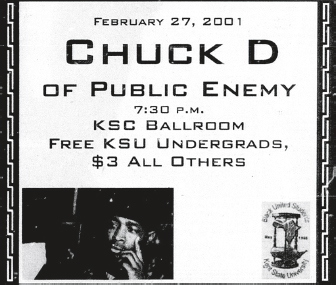
Advertisement for Chuck D in Kent (Courtesy of the Daily Kent Stater)
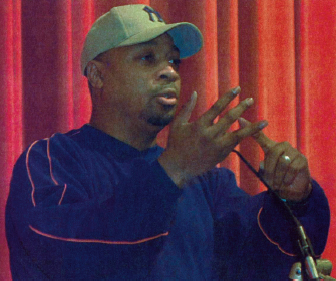
Chuck D of the ’90s rap group Public Enemy addresses an intimate crowd in the Student Center Ballroom. (Daily Kent Stater photo by Alex Capaldi)
He offered the life of Tupac Shakur as a perfect example of this.
“You can sell a dead man forever—just ask Hendrix,” he said. “You don’t have to negotiate with a dead man.”
In light of his recent advocacy of free music online, Chuck D described the corporate dictation that powers the music industry. Artists, he said, traditionally make 10 percent profit from each album they sell. By providing their music directly to consumers via the Internet, artists stand to lose little and also gain control of its production and distribution, he said.
“The big fight is about the technology being in the hands of the public before big businesses got it,” he said of the recent Napster trial.
Applauding the recent headlines of all-time low consumer confidence, he described the Internet as the harbinger of equity in music.
He also described Radio Attack Terrorists, a group he recently founded to combat corporate control of broadcasting and subsequent onesided imaging of African Americans.
The group has a Web site on which visitors can deliver e-mail grenades and electronic bombardments showing the sender’s dismay of negative and lopsided programming to the stations of their choice. Further measures Chuck D will take include the publication of broadcast executives’ phone numbers, social security numbers and addresses. This notion was met with audience approval.
“It’s a really good idea to bomb the radio stations by e-mail. They only play who pays them to,” said Jason Collins, a senior ceramics major. “It’ll mess their system up.”
“It was shocking, but I think that profane and sexist music should stop being played,” said Rochelle McCrayer, a freshman exploratory major. “I would like to hear more positive stuff, like Jill Scott, on the radio.”
Concluding his talk, the influential Hip Hop pioneer recommended that students get the most of their education and experience life outside of their comfort zones. He bragged that his greatest accomplishment was going through three passports.
The Spitfire Tour show was on Tuesday, October 30, 2001.
Spitfire Tour Drops by to Rally Kent State Students
by Jennifer Kovacs
Daily Kent Stater
October 31, 2001
Musicians, including Nirvana bassist Krist Novoselic and Dead Kennedys founder Jello Biafra, encouraged Kent State students to become involved in political activism last night in the Student Center Ballroom.
The May 4 Task Force hosted the Spitfire Tour, which includes musicians, actors and activists speaking on global affairs.
“We always have a fall program, and this year I wanted something big,” said Kelley Garbett, co-chair of the task force. “It’s an incredibly good show for the amount of money it costs, and it’s incredibly unique. They all have an important thing to say.”
Adam Werbach, host of the new magazine The Thin Green Line, mediated the event. The musicians, who spoke on various political topics, were Novoselic, Biafra, singer/songwriter Jill Sobule, founder of the Joint Artists and Music Promotions Political Action Committee.
Novoselic opened the show by urging students to participate in electoral reform.
“The electoral process is like a rundown greasy spoon,” Novoselic said. “You go in and there’s one table but only two chairs, and they’re reserved for Republicans and Democrats.”
Novoselic promoted an inclusive democratic process that would make it possible for third-party candidates to run in elections.
“I really liked what Krist had to say,” senior English major Sue Savickas said. “The more informed people are, the easier it is to get younger people to make a difference.”
Sobule performed an acoustic set of songs of social commentary, including one on the difference between drug laws for George W. Bush and a kid across the tracks.
Biafra argued against the war in Afghanistan.
“I’m frightened of Bush saying, ‘You’re with us or with the terrorists,” Biafra said.
“We need to stand up and say, ‘No, we’re not with Bush or the terrorists. Is what we’re doing now really the best way to solve the problem?’ What happened to rethinking what made these people so mad in the first place?”
Joe Walsh received his honorary degree on Saturday, December 15, 2001.
Graduation Day at KSU—Call Him Dr. Walsh
Rocker Gets Honorary Degree, Campbell Speaks
By Deborah Guziak
Kent Record-Courier
December 16, 2001
Kent State University bestowed an honorary degree on a Rock and Roll Hall of Famer and heard from Cleveland’s incoming mayor as 1,650 graduates received their degrees during commencement ceremonies Saturday.
Guitarist Joe Walsh of the Eagles received an honorary doctorate degree during the morning commencement exercises and Cleveland Mayorelect Jane Campbell addressed the afternoon exercises at the Memorial Athletic and Convocation Center.
Walsh, who received his degree as Joseph Fidler Walsh, was presented with the pink hood representing the music doctorate. He attended classes at KSU from 1965 to 1967 but did not graduate. “I’ve been a junior for 27 years, in good standing, I might add,” he joked.
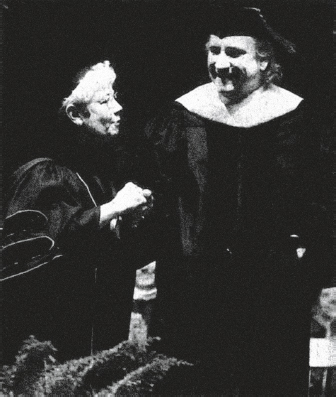
Kent State University President Carol Cartwright congratulates guitarist Joe Walsh on his honorary doctorate degree at commencement exercises at KSU. (Record-Courier photo by Richard Sweet)
Although he did not speak during the commencement, Walsh said after the exercises that receiving the honorary doctorate was a humbling experience.
“It kind of puts closure on my school days,” Walsh said. “It always bothered me that I didn’t finish school. This makes me feel very humble to be recognized, and it reconnects me to a time when I was just ‘Joe.’”
Walsh left KSU in 1967 to perform in a band called the Measles, which was a popular group in the Kent music scene at that time. He later joined the James Gang. He recorded a solo project in 1973 and joined the Eagles in 1976.
He lived in Columbus as a child and said he came to Kent in 1965 because he felt it was a safe community. He lived in Manchester Hall and was a political science major before converting to an English major.
“I loved Kent,” he said. “It was a time that allowed me to be very creative. I played downtown, and received a tremendous amount of encouragement. I still have friends here.”